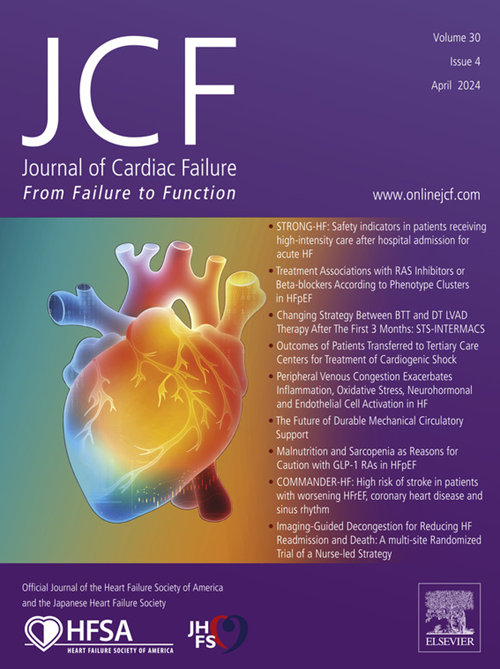GLP-1受体激动剂对心力衰竭患者射血分数轻度降低或保留的疗效:系统回顾和荟萃分析
IF 6.7
2区 医学
Q1 CARDIAC & CARDIOVASCULAR SYSTEMS
引用次数: 0
摘要
背景:心力衰竭伴轻度射血分数降低或保留(HFpEF)占心力衰竭病例的一半以上,其中肥胖起关键作用。尽管有现有的治疗方法,剩余风险仍然很高。胰高血糖素样肽-1受体激动剂(GLP-1RAs)已显示出潜在的心脏代谢益处,但它们在HFpEF中的作用尚不清楚。方法:对评价HFpEF中GLP-1RAs的随机对照试验(rct)进行系统回顾和荟萃分析。还包括评估GLP-1RA与葡萄糖依赖性胰岛素性多肽(GIP)联合作用的研究。分析的结果包括心血管(CV)死亡、心衰(HF)事件恶化及其复合。风险比(hr)和95%置信区间(ci)采用随机效应模型进行汇总。结果:纳入6项随机对照试验,共8788例患者。GLP-1RAs显著降低CV死亡或心衰恶化事件的综合结局(HR: 0.68 [0.51-0.89], p = 0.006,I² = 47%)以及单独心衰恶化事件的综合结局(HR: 0.56 [0.38-0.82], p = 0.003,I² = 51%)。单独的CV死亡率无显著降低(HR: 0.86 [0.67-1.12], p = 0.27,I² = 0%)。结论:GLP-1RAs可减少HFpEF中恶化的HF事件和CV死亡或恶化HF的复合,特别是在肥胖或糖尿病患者中。这些发现支持了它们作为一种有希望的治疗方法的作用,需要进一步以hfpef为重点的试验。本文章由计算机程序翻译,如有差异,请以英文原文为准。
Efficacy of GLP-1 Receptor Agonists in Patients With Heart Failure and Mildly Reduced or Preserved Ejection Fraction: A Systematic Review and Meta-Analysis
Background
Heart failure (HF) with mildly reduced or preserved ejection fraction (HFpEF) accounts for over half of cases of HF, with obesity playing a key role. Residual risk remains high despite available therapies. Glucagon-like peptide-1 receptor agonists (GLP-1RAs) have shown potential cardiometabolic benefits, but their role in HFpEF remains unclear.
Methods
A systematic review and meta-analysis of randomized controlled trials evaluating GLP-1RAs in HFpEF were conducted. Studies evaluating GLP-1RA in combination with glucose-dependent insulinotropic polypeptide (GIP) were also included. The analyzed outcomes included cardiovascular (CV) death, worsening HF events and their composite. Hazard ratios (HRs) with 95% confidence intervals (CIs) were pooled by using a random-effects model.
Results
Six randomized controlled trials involving 8788 patients were included. GLP-1RAs significantly reduced the composite outcome of CV death or worsening HF events (HR: 0.68 [0.51–0.89]; P = 0.006, I² = 47%) as well as worsening HF events alone (HR: 0.56 [0.38–0.82]; P = 0.003, I² = 51%). No significant reduction was observed for CV death alone (HR: 0.86 [0.67–1.12]; P = 0.27, I² = 0%).
Conclusion
GLP-1RAs reduce worsening HF events and the composite of CV death or worsening HF in HFpEF, particularly in patients with obesity or diabetes. These findings support their role as a promising therapy requiring further HFpEF-focused trials.
求助全文
通过发布文献求助,成功后即可免费获取论文全文。
去求助
来源期刊

Journal of Cardiac Failure
医学-心血管系统
CiteScore
7.80
自引率
8.30%
发文量
653
审稿时长
21 days
期刊介绍:
Journal of Cardiac Failure publishes original, peer-reviewed communications of scientific excellence and review articles on clinical research, basic human studies, animal studies, and bench research with potential clinical applications to heart failure - pathogenesis, etiology, epidemiology, pathophysiological mechanisms, assessment, prevention, and treatment.
 求助内容:
求助内容: 应助结果提醒方式:
应助结果提醒方式:


